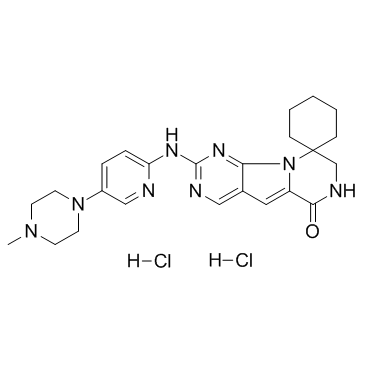Trilaciclib hydrochloride
Modify Date: 2024-01-05 17:04:24

Trilaciclib hydrochloride structure
|
Common Name | Trilaciclib hydrochloride | ||
|---|---|---|---|---|
| CAS Number | 1977495-97-8 | Molecular Weight | 519.470 | |
| Density | N/A | Boiling Point | N/A | |
| Molecular Formula | C24H32Cl2N8O | Melting Point | N/A | |
| MSDS | N/A | Flash Point | N/A | |
Use of Trilaciclib hydrochlorideTrilaciclib hydrochloride is a CDK4/6 inhibitor with IC50s of 1 nM and 4 nM for CDK4 and CDK6, respectively. |
| Name | Trilaciclib hydrochloride |
|---|---|
| Synonym | More Synonyms |
| Description | Trilaciclib hydrochloride is a CDK4/6 inhibitor with IC50s of 1 nM and 4 nM for CDK4 and CDK6, respectively. |
|---|---|
| Related Catalog | |
| Target |
Cdk4/cyclin D1:1 nM (IC50) cdk6/cyclin D3:4 nM (IC50) |
| In Vitro | Incubation with Trilaciclib hydrochloride (G1T28) for 24 hours induces a robust G1 cell-cycle arrest (time=0). By 16 hours after Trilaciclib hydrochloride washout, cells have reentered the cell cycle and demonstrate cell-cycle kinetics similar to untreated control cells. These results demonstrate that Trilaciclib hydrochloride causes a transient, and reversible G1 arrest. A transient Trilaciclib hydrochloride-mediated G1 cell-cycle arrest in CDK4/6-sensitive cells decreases the in vitro toxicity of a variety of commonly used cytotoxic chemotherapy agents associated with myelosuppression[1]. |
| In Vivo | Trilaciclib hydrochloride (G1T28) treatment results in a robust and dose-dependent suppression of proliferation in HSPCs at 12 hours, with 5-ethynyl-2′-deoxyuridine (EdU) incorporation returning near baseline levels in a dose-dependent manner by 24 hours after administration. These data demonstrate that a single oral dose of Trilaciclib hydrochloride can produce reversible cell-cycle arrest in HSPCs in a dose-dependent manner in vivo. Mice given 100 mg/kg Trilaciclib hydrochloride 30 minutes prior to etoposide treatment, exhibits only background levels of caspase-3/7 activity. These data demonstrate that Trilaciclib hydrochloride can protect the bone marrow from chemotherapy-induced apoptosis in vivo. The data demonstrate that treatment with Trilaciclib hydrochloride prior to 5-fluorouracil (5-FU) likely decreases 5-FU-induced damage by chemotherapy in HSPCs, thus accelerating blood count recovery after chemotherapy[1]. |
| Kinase Assay | HS68, WM2664, and A2058 cells are treated with 300 nM Trilaciclib hydrochloride (G1T28) or DMSO (0.1%), for 4, 8, 16, or 24 hours. Whole cell extracts are prepared using 1× radioimmunoprecipitation assay buffer containing 1× HALT protease and phosphatase inhibitors. Total protein concentration is determined by using the kit, according to the manufacturer's instructions. For Western blot analysis, protein is processed as described previously. Antibodies to total RB and β-tubulin run as a loading control are assessed[1]. |
| Cell Assay | HS68 cells are treated for 24 hours with Trilaciclib hydrochloride (G1T28) at 10, 30, 100, 300, 1,000, or 3,000 nM final concentration. Cells are harvested and fixed in ice-cold methanol. Fixed cells are stained with 20 μg propidium iodide, 50 μg RNAse A in PBS-CMF (calcium magnesium free) +1% BSA, Fraction V. Samples are processed on Cyan ADP Analyzer, and cell-cycle analysis is completed using software[1]. |
| Animal Admin | Female athymic nude mice are implanted with H69 cells and monitored until treatment initiation. Once tumors reach an acceptable size (150 mm3), mice are dosed in various combinations of Trilaciclib hydrochloride (G1T28) and topotecan for 5 days per week for 4 weeks. Tumors are measured for up to 60 days after treatment. All mice that reach excessive tumor burden before 60 days are humanely euthanized. Topotecan and Trilaciclib hydrochloride levels in blood plasma from the mice treated with Trilaciclib hydrochloride and/or topotecan are processed and analyzed using established methods[1]. |
| References |
| Molecular Formula | C24H32Cl2N8O |
|---|---|
| Molecular Weight | 519.470 |
| Exact Mass | 518.207642 |
| Storage condition | 2-8℃ |
| 4BX07W725T |
| 2'-{[5-(4-Methyl-1-piperazinyl)-2-pyridinyl]amino}-7',8'-dihydro-6'H-spiro[cyclohexane-1,9'-pyrazino[1',2':1,5]pyrrolo[2,3-d]pyrimidin]-6'-one dihydrochloride |
| Spiro[cyclohexane-1,9'(6'H)-pyrazino[1',2':1,5]pyrrolo[2,3-d]pyrimidin]-6'-one, 7',8'-dihydro-2'-[[5-(4-methyl-1-piperazinyl)-2-pyridinyl]amino]-, hydrochloride (1:2) |